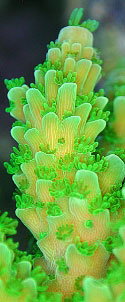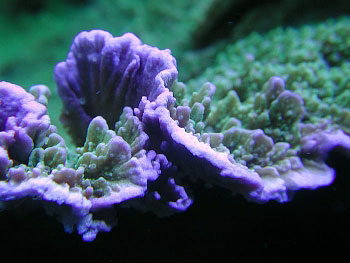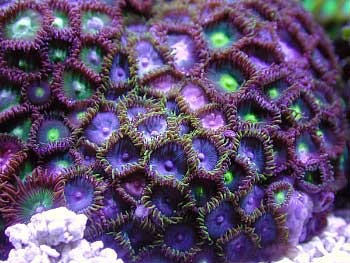
|
|
|
Robie Sayan's (ROBZ) Reef Aquarium
First, I would like to thank Reefkeeping for featuring my tank. It is an honor being able to share my aquarium with all of your readers. My love for nature has driven me to dedicate and care for it with much time, effort and patience. Background & Thoughts on the Hobby:
My name is Robie Sayan. I am originally from Lima, Peru. I grew up close to the ocean, enjoying the surf, scuba diving and snorkeling. I am fascinated by everything related to the ocean; it has always given me an inner sense of tranquility. I've constantly been interested in marine life, with all of the amazing colors and by the different and amorphous shapes it creates. It is a feeling difficult to put into words and can only be experienced when coming in contact with a reef tank full of exciting creatures. I am sure my fellow reefkeepers can understand what I mean. I've been in this hobby for the last seven years, having transitioned from fish-only systems to soft corals, then finally on to SPS corals and a mixed reef. It has been a long evolution and a learning process that has given me much enjoyment as well as allowing me to make many good friends throughout this time, both online or through local clubs. This, in turn, has allowed me to exchange information, experiences, and fragments. If you are like me, you can never say, "I will get a simple system … nothing too complicated." If you do, you will eventually realize that you are in denial! There are so many gadgets, new toys and technologies that will eventually get you carried away. I would suggest trying to be smart in what you choose to invest in, especially when considering what you are planning on keeping in your "box." In my own case, I have a soft spot for splurging a bit too much on SPS corals. I am sure you, too, will get hooked one day!
The Tank: The tank is a reef-ready 90 gallon All Glass Aquarium (48' x 24" x 18"), and it has been running for almost a year. It was an upgrade from a smaller tank that after two years had been filled to capacity at a very fast rate, creating the need for something a bit larger. Some of the corals and fish have been with me for quite a long time. The stand and canopy were custom-built by a good friend of mine, Arquimedez Diaz, who is a "Master Wood Carpenter" that lives and works in Florida. The cabinet is made with a flexstone texture on the outside, and lined with Formica inside both the stand and the canopy. The fun part was painting it myself when I set it up.
In addition to the main display there is a 33 gallon tank (48" x 12" x 13") connected to the system which is used both for propagation and as a refugium. It contains several different types of macro algae, mangroves and invertebrates. It's also home to several anemones and coral fragments from the main display as well as providing housing for some recent additions to my collection.
Filtration: The sump is an acrylic tank made by Advance Aquaria with approximately a 40 gallon capacity. The protein skimmer, located in the sump, is from Sealife Systems and is a venturi type rated for a 150 gallon system. It does a pretty good job and is very compact. For bio-filtration there is about 70 lbs. of mixed live rock consisting of assorted pieces of Tonga branch, Fiji, Samoa and some various pieces of shelf rock. The substrate is a three inch deep live sediment bed, consisting of a mixture of Southdown sand and crushed coral. Mixed Caulerpa algae and mangroves are used for nutrient export in the propagation/refugium tank. Circulation: The main return pump is a Quiet-One from Rainbow Lifeguard and its output runs through a SQWD water-oscillating device, which switches the flow between two returns on either side of the tank. For additional circulation I use four Maxi-Jet 1200 powerheads connected to a Wavemaster Pro wavemaker (three of which are located in the main display and one in the prop tank). Circulation in the propagation/refugium tank is provided by a Mag7 pump which returns through a ½" Sea Swirl. Lighting:
Lighting for the main tank consists of two 400 watt 20K Radium bulbs run by two electronic ballasts. Additionally, these are supplemented by two 96 watt power compact true actinic bulbs, also powered with electronic ballasts. Two 4" Ice-Cap fans capable of moving 50 CFM with a built-in thermal speed control are used to ventilate the canopy. On the prop tank two 250 watt metal halide 20K Radium bulbs are used. SpiderLight™ reflectors (mounted parallel) are used on all the metal halides and although they are not very fancy, they seem to work great at providing an excellent light spread. As an added bonus, the tanks also receive some degree of direct sunlight, since I live in a 10th floor apartment that is very sunny with the tanks situated near a large picture window.
Other Equipment: With all the intense lighting on the system and the heat it produces it was necessary to add a 1/4 HP Pacific Coast Imports inline chiller. This keeps the tank temperature in the 79-80º F range. Top-off water is supplied from a 15 gallon glass aquarium used as a small reservoir and is connected inline to a Nielsen kalkwasser reactor. In addition to the Nielsen reactor, a Korallin 1502 calcium reactor is also used to keep up with the high calcium demands of the SPS corals. It is an indispensable piece of equipment that has a very compact design.
Maintenance: A ten gallon water change is performed monthly using Instant Ocean salt. An Ultralife RO unit, producing up to 50 gallons per day, provides the make up water, and I generally make RO water every 10 days to refill the reservoir and for making salt water for water changes. Weekly chores include cleaning the skimmer cup and adding Kent Marine's strontium and Lugol's solution. Once a month, I'll break down the skimmer entirely and give it a good cleaning. The Nielsen reactor is refilled about every two weeks with Kent Marine Kalkwasser mix. The calcium reactor is monitored daily, just in case it needs to be tuned.
Feeding:
On a daily basis the tank receives a variety of foods such as brine shrimp, mysid shrimp, prawn, silversides, squid, or frozen plankton. These are all mixed with a few drops of Zoecon (food enhancer). Additionally, I also feed some dry food such as various flake foods of different types, trying to keep a diverse diet for the fish, inverts and corals. Inhabitants: The main display is home for many SPS corals that are situated in the middle and upper slopes of the tank while the bottom is lined with a garden of zoanthids and different types of mushrooms, mostly Ricordea. Acropora:
Montipora:
Note: All species designations are my best guesses or how I acquired them.
Other Corals:
Fish:
Invertebrates:
There are numerous polyp colonies such as zoanthids, Palythoa spp., Parazoanthus spp., green star polyps, Xenia spp., clove polyps, and there are many others that I am growing as frags in the propagation tank.
Concluding Thoughts: Finally, I would like to share that throughout these years in the hobby it has been especially rewarding learning about the creatures I keep. I am continuously learning new things and meeting really great people who have allowed me to learn through their own experiences. The advice I would like to give any new hobbyist is that they should plan ahead of time before setting up a system. Read, do some research and go to the different forums where you will find all the information needed to start a beautiful "REEF AT HOME." Remember, we are responsible in keeping these creatures in a healthy and friendly environment! Have fun and be patient, it will pay off.
To visit my website, click on the image below: Feel free to comment or ask questions about my tank in the forum for the online magazine. |


























































